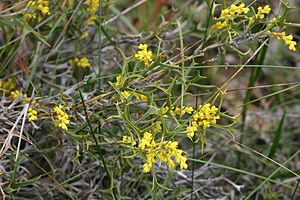Synaphea facts for kids
Quick facts for kids Synaphea |
|
|---|---|
 |
|
| Synaphea spinulosa subsp. spinulosa | |
| Scientific classification |
|
| Kingdom: | Plantae |
| Clade: | Tracheophytes |
| Clade: | Angiosperms |
| Clade: | Eudicots |
| Order: | Proteales |
| Family: | Proteaceae |
| Subfamily: | Proteoideae |
| Tribe: | Conospermeae |
| Subtribe: | Conosperminae |
| Genus: | Synaphea R.Br. |
Synaphea is a group of small shrubs. These plants are special because they are found only in Western Australia. This means they are endemic to that area. Synaphea plants have leaves that can look very different from one another. However, their flowers are always yellow. They also have a very interesting way of being pollinated!
Contents
What Synaphea Plants Look Like
Plants in the Synaphea group are small shrubs. They usually have leaves that are deeply divided into many parts. This is called pinnatipartite. Some types have simple leaves, while others have leaves divided like a feather, called pinnate. The leaves also have a stalk, called a petiole, with a base that wraps around the stem.
The flowers are quite small and bright yellow. They usually do not have a smell. These flowers grow in spikes. You can find them where a leaf meets the stem, or at the ends of branches. Each flower has a tube-shaped outer part, called a perianth. This tube opens up about halfway.
How Synaphea Flowers Pollinate
Like many other plants in the Proteaceae family, Synaphea flowers have a special trick for pollination. The male parts, called anthers, and the female part, called the style, start out touching each other. The end of the style acts like a "pollen presenter." This means it holds the pollen ready to be picked up.
In Synaphea plants, the anthers and stigma are held together tightly. They are under tension, like a spring. They only separate when an insect or other pollinator touches them. When touched, they quickly spring open and shoot out the pollen! This helps the pollen stick to the pollinator. After the flower is pollinated, it grows a hard-shelled nut as its fruit. But for most types of Synaphea, not many seeds actually grow from these nuts.
Naming and History of Synaphea
The group of plants called Synaphea was first officially described in 1810. This was done by a famous botanist named Robert Brown. He wrote about it in a scientific book called Transactions of the Linnean Society of London.
The very first species Brown described was Synaphea favosa. This plant is now known as the type species for the whole group. The name Synaphea comes from an ancient Greek word, synaphe. This word means "a connection" or "a union." It refers to how a part of the flower (a sterile anther) is connected to the stigma.
Different Kinds of Synaphea
There are many different types of Synaphea plants. Scientists have given each one a unique name. Here are a few examples of the species and subspecies that are officially recognized:
- Synaphea acutiloba - also known as granite synaphea
- Synaphea favosa
- Synaphea petiolaris
- Synaphea petiolaris subsp. petiolaris
- Synaphea pinnata - also known as Helena synaphea
- Synaphea polymorpha - also known as Albany synaphea
- Synaphea spinulosa
- Synaphea spinulosa subsp. spinulosa
Where Synaphea Plants Grow
All Synaphea plants are found only in Western Australia. This means they are native to this specific part of the world.
See also
 In Spanish: Synaphea para niños
In Spanish: Synaphea para niños

